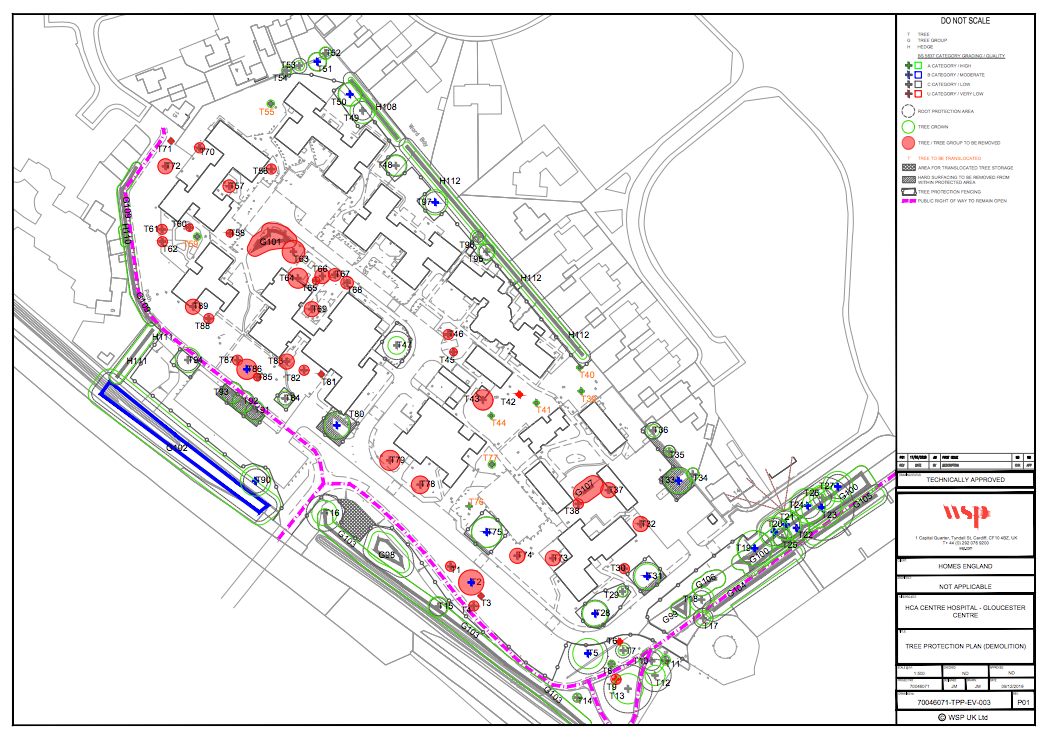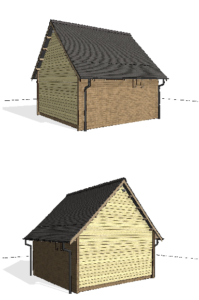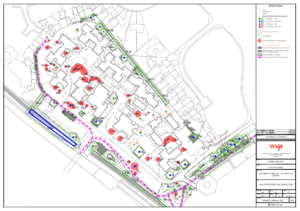
Tree Felling Objection
About:
Planning Objection:
- This is part of an objection to a residential development that demolishes many buildings including 16 bat roosts
- So far there appears to be no need to apply for planning permission to fell the trees, just demolish building and the trees go with them.
- ‘Lost’ in the Planning Application to demolish is a tree survey that (following public objections) proposes to modify ‘clear fell every tree’ to ‘protect some and fell others’.
- Application for Demolition
- This is a case study of a Full Planning Application objection by residents
- It is recorded here to help other residents understand the process of objecting to a Planning Application
- GBE have include documents and templates that can be edited and made specific to other sites
- We do not yet know the outcome but will update this page as it happens
A Diversion: Bat Barn and Bat Box Posts
- A separate full planning application has been submitted for the Bat Barn and additional Bat Box Posts
- We have prepared feedback, awaiting community feedback
- We will submit in due course.
- Second Draft
Gloucester Centre Site Bat Barn & Posts Full Planning Application
Planning policy relevant to this application:
The Peterborough Local Plan 24th July 2019.
LP28: Biodiversity and Geological Conservation.
Part 3 Mitigation of Potential Adverse Impacts of Development should avoid adverse impact on existing biodiversity and geodiversity features as a first principle.
Where adverse impacts are unavoidable they must be adequately and proportionately mitigated.
- The residential development can be designed to avoid adverse impact on existing trees if the designer is briefed to do so.
- Instead the development plan sets out to maximise the number of houses and standardise the plot sizes by ignoring all the tree locations
- This approach focuses on de-risking the development to enable sale and maximise profits for the developer.
- This site is not seen as a viable site for profit making by normal developers, it should be treated differently
- But by bundling the site up with another the sale of the site is guaranteed, so focus shifts to profitability.
- There are other ways to develop site where the big profit motivation is not the first principle
- This with-profits approach is avoidable if plots are sold to individuals who are interested in quality over quantity
- Only by knowing the number of bats by way of surveys can mitigation be proportionate or enhanced
- The bat barn and bat box poles as currently proposed do not adequately mitigate.
If full mitigation cannot be provided, compensation will be required as a last resort where there is no alternative.
- We do not want any party increasing it coffers at the expense of biodiversity on this site.
1d) Habitats and Species of Principal Importance
The council will consider all development proposals in the context of its duty to promote the protection and recovery of priority species and habitats.
Where adverse impacts are likely, development will only be permitted where the need for and benefits of the development clearly outweigh these impacts.
In such cases, appropriate mitigation or compensatory measures will be required.
- Has he PCC T&CP scrutinised the proposal under this hierarch?
- Can the residents see this scrutiny?
-
Biodiversity and Geodiversity in Development
All development proposals should:
Conserve and enhance the network of habitats, species and sites (both statutory and non-statutory) of international, national and local importance commensurate with their status and give appropriate weight to their importance;
Avoid negative impacts on biodiversity and geodiversity;
Deliver a net gain in biodiversity, where possible, by creating, restoring and enhancing habitats and enhancing them for the benefit of species;
- Numbers of species of bats were not recorded so net gain cannot be determined
Where necessary, protect and enhance the aquatic environment within or adjoining the site, including water quality and habitat.
For riverside development, this includes the need to consider options for riverbank naturalisation.
- Does this apply to SuDS pond-side naturalisation
In all cases regard should be had to the council’s Flood and Water Management SPD.
All development proposals should complete the council’s biodiversity checklist to identify features of value on and adjoining the site and, for major development proposals, provide an audit of losses and gains in existing and proposed habitat.
- Can residents see the Biodiversity checklist?
- Can residents see the Audit of losses and gains?
- How can losses and gains be assessed if no period of time is given between mitigation and demolition of roosts.
Where there is the potential for the presence of protected species and/or habitats, a relevant ecological survey(s) must be undertaken by a suitably qualified ecologist.
- A bat study has been carried out
- Is there a wider ecological survey been carried out?
- Are there any recommendation to address mitigation for other species and habitats?
The development proposals must be informed by the results of both the checklist and survey.
In all cases, regard should be had to the council’s Green Infrastructure and Biodiversity SPD.
- Should = wishy washy unreliable word
- Shall = robust and reliable word
- Will they?
Trees and Woodland Local Policy 2019
6.24.2 Trees provide a broad range of benefits from providing wildlife habitat, adding maturity to new sites, screening, shade, storm water attenuation, visual amenity and the ability to soften and complement the built form.
- We wish to remind the owners, agents, developers and planners 40 year old, mature, but not decrepit, trees are an asset that give the site real character, provides for biodiversity, and would enhance any development proposal (if a little inconvenient to persistently profit hungry parties)
- But the housing development planning application will remove all the trees and force biodiversity off site to compete for space in other overcrowded landscapes.
Policy LP22 Green Infrastructure Network
The council, working in partnership with conservation and environmental organisations, local communities, developers and statutory agencies, will seek to maintain and improve the existing green infrastructure network in Peterborough.
- It fees like the local community is being ignored here
This will be achieved by enhancing, creating and managing multi-functional green infrastructure, within and around settlements, that are well connected to each other and the wider countryside, and which reflect the broad strategic framework set out in the Green Infrastructure and Biodiversity SPD.
The council will take into account the latest Open Space Strategy, Green Infrastructure and Biodiversity SPD and any other appropriate local evidence to guide applicants on what new green infrastructure will be required and how it should be delivered.
All development proposals should ensure that existing and new green infrastructure is considered and integrated into the scheme design from the outset.
Where new green infrastructure is proposed, the design should maximise the delivery of ecosystem services and support healthy and active lifestyles.
Strategic and major development proposals should incorporate opportunities for green infrastructure provision, to reverse the decline in biodiversity and restore ecological networks at a landscape scale, reverse habitat fragmentation and increase connectivity of habitats, and to preserve, restore and create priority and other habitats within and adjacent to development schemes.
- This proposal leads to a decline in biodiversity by demolishing the existing buildings with roosts provides alternative roosts remote from the existing roost and foraging locations decreasing connectivity and existing food sources trees contrary to this requirement.
Proposals will be expected to provide clear arrangements for the long-term maintenance and management and/or enhancement of green infrastructure assets.
- 20-25 year life expectancy bat roosts is short term and so provisions need to be made to ensure the roosts are maintained and replaced at the end of this life
Where appropriate, the council may utilise planning conditions, CIL or planning obligations to deliver green infrastructure projects.
Development must protect the existing linear features of the green infrastructure network that provide connectivity between green infrastructure assets, including public rights of way, bridleways, cycleways and waterways, and take opportunities to improve such features.
Development proposals that cause loss or harm to the green infrastructure network will not be permitted, unless the need for and benefits of the development demonstrably outweigh any adverse impacts.
Where adverse impacts on the green infrastructure network are unavoidable, development will only be permitted if suitable mitigation measures for the network are provided.
Development proposals which are consistent with and support the delivery of the opportunities, priorities and initiatives identified in the Peterborough Green Infrastructure and Biodiversity SPD will be supported.
Quotes taken from Peterborough @Environmental Capital Winter 2019 E- newsletter
There has been a dramatic decline in wildlife habitats and species during the last 50 years.
For example 2,200 km of hedgerow were lost in Cambridgeshire between 1984-90 and nation-wide there have been 50% losses in the last 25 years of once common species such as hedgehogs and toads.
- The demolition and development proposals removes all trees, bushes, shrubs, hedgerows to add to this problem
What we need to do?
Create a city with a robust, well managed network of wildlife-rich and accessible natural places which support a wide range of animals and plants and provides plentiful opportunities for local people to actively engage with and better understand their natural surroundings.
- But planners and developers seem to be immune, “Its not my problem” “let somebody else do it”.
- We cannot carry on in this fashion, stand up and be counted, hold yourself accountable.
Declare a Climate Emergency:
Peterborough City Council Carbon Management Action Plan 1st Feb 2020
https://www.climateemergency.uk/blog/peterborough-2/
- Is focussed on carbon only but also addresses energy efficiency but lets itself down by “address at least one of the options”
- No comprehensive plans to reduce carbon % by any deadline
- No strong ambition here.
- It focuses on its own ‘estate’ proposal and not all occupants of its ‘zone of influence’
- Most of the improvements 2005-2017 have been made in the wider Industry & Commercial sectors and a nominal improvement in Housing. (Fig 2.)
- 1.2 Tree planting is focussed on Carbon Sequestration and Carbon Offsetting, no interest shown in Biodiversity.
Comments on planning application:
- The separation of the three (so far) planning applications including the mitigation, demolition, and development lends itself to lack of joined up thinking, joined up design, joined up scrutiny and joined up public feedback
- Is this a ploy to simplify the applications, complicate and enable discounting of points raised in one application related to both the primary and other applications; and deter residents from giving any feedback?
- Covering letter refers to Arboricultural report that appears to be missing
- Planning application form:
- Question 10 Trees and Hedges: Are there trees or hedges on land adjacent to the proposed development site that could influence the development or might be important as part of the local landscape character?
- Response: NO
- This does not acknowledge the site boundary hedgerow and tree line, nor the adjacent proposed residential site that has nearly 100 mature healthy trees and many shrub areas in existence that are absolutely important as part of the landscape character and vital for the sustainability of the existing wildlife.
- See also separate file on local residents comments about the surrounding trees adding so much to the area, a real impression of living in the countryside, reasons to come here, reasons to stay and reasons to leave if the trees are felled.
- At least 4 of the existing trees are known to be home to insects that are food for the bats.
- Unquestionably the remainder of the trees, bushes and planting support biodiversity, their loss will result in loss of biodiversity on this site.
- See Separate file on observed wildlife on site and surrounding estate much of which disappear into the site’s planting for cover and foraging.
- Other observed wildlife on the site includes: Foxes, Hedgehogs, Deer, Birds
- What provision is being made for these?
Comments by local residents
Maintaining Biodiversity on the site and surroundings:
- We will continue to object to the proposed residential development, which proposes to demolish existing bat roosts and fells 96 mature trees, some of which are known to be bat foraging ground and food-source tree species.
- However if the residential proposal gets bulldozed through the planning process unscathed, then we want some assurance that the documented and observed wildlife on the site and surroundings is to be maintained, enhanced and not just abandoned.
- See Local Policy above
- To be assured of success the bat provisions need to be in place and in use well in advance of the proposed demolition for development.
- So the early application for bat and bird provision is welcomed, but its implementation needs to be immediate, and monitoring for occupation, needs to start as soon as it is complete.
- Only when the successful and long-term transfer of bats from their existing roosts to the bat barn and bat box poles has happened should permission be granted for a significantly improved residential development.
- However WSP the named ecologist
- (Also the designer of the residential development
- potential conflict of interest?)
- Will monitor for 5 years after construction
- But no set period, before demolition of existing roosts, to ensure the bats have successfully transferred and not left the site altogether
- (Also the designer of the residential development
- There is no mention in the proposal for encouraging the existing bats out of their existing roosts and into the proposed bat barn or bat box poles, as if it will happen by magic.
- Licenced manual transfer does not guarantee the bats will stay, but return to their existing roosts, nor that it will be a success.
- There is no provision in this applications for planting food-source tree species to replace the ones envisage to be felled for the recent outline proposal for residential development.
- Trees will need time to mature to become the home of the species that are the food source for the bats.
- If the combination of the two proposals result in a loss of food source then the proposals are unlikely to succeed.
- The separation of the two planning applications lends itself to lack of joined up thinking and joined up design
- The changes in site levels in the residential development will undermine the foundation of at least 3 of the bat box poles.
- Where are the provision for the other observed wildlife inhabiting or using the site and surroundings?
- Swallows are provided for but are they present here?
- There are case studies of multi-functional multi-species purpose made buildings available.
© GBE NGS ASWS Brian Murphy aka BrianSpecMan *
5th April 2020
Tree Felling Objection
Images:
FaceBook Group Page

Gloucester Centre Residents FaceBook Page
Tree felling and protection
Bat barn

Project
- Pinterest Section Gloucester Centre Site
Development Public Displays
Leaflet Posting
Residents Tree Survey
- Pinterest Section Tree Survey
Residents Wildlife Survey
- See facebook page
- The Gloucester Centre Build
© GBE NGS ASWS Brian Murphy aka BrianSpecMan *
23rd March 2020 – 5th April 2020
Bat Barn Bat Box Post Objection
See Also:
GBE Books
- Designing for Biodiversity: A technical guide for new and existing buildings G#535 N#555
- Designing for Biodiversity: A Technical Guide for New and Existing Buildings G#1328 N#1316
GBE CPD
GBE CPD Titles
GBE CPD Topics
- Biodiversity CPD Topic (Navigation) G#568 N#588
GBE Jargon Buster
GBE Jargon Buster Theme
- Biodiversity (Jargon Buster Theme) G#645 N#667
GBE Case Studies
GBE Building Case Studies
GBE Case Study Objections
- Gloucester Centre Development (Objection) G#28968
- Bat Barn Bat Box Posts (Objection) G#38145
- Gloucester Centre Demolition (Objection) G#38285
- Tree Felling (Objection) G#38325 (this page)
GBE Information
- National Policy Framework
- Local Plan
- Local Plan Improvement Campaign
- Climate Emergency Declaration
- Climate Emergency Response
© GBE NGS ASWS Brian Murphy aka BrianSpecMan *
5th April 2020


